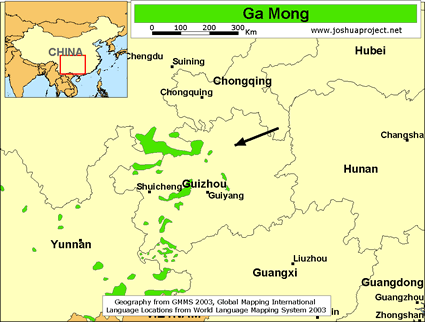The Ga Mong claim a history dating back as far as the Song Dynasty (AD 960-1279). During the Ming Dynasty (1368-1644), the Ga Mong were a powerful group and were constantly fighting and defending their territory. At one stage 13 armed groups of Ga Mong attacked the city of Duyun.
Until 1997 the Ga Mong were combined with numerous other groups to form the Miao nationality in China and were called Dong Jia by the Chinese. Jia means "family" or "household." There is a larger Dong people group in the Eastern Guizhou Province and an official Dong minority referred to using a different Chinese character. The Ga Mong is separate from both of these. The Ga Mong speak their own language and have their own set of customs, different from all other peoples in the area. This group calls itself Ga Mong or Ge Mong. Local Chinese call them Yangya Miao which means "duck raising Miao." In 1997 the government reclassified the Ga Mong into the She nationality, the majority of whom are located in Fujian and Guangdong provinces. The Ga Mong are upset with this change; they demand to be given their own status.
The Ga Mong celebrate their own set of festivals. Every year on the 18th of October they stage bullfights and cockfights and have a massive communal feast. Prominent family names among the Ga Mong include Wu, Luo, Gin, Ting, Wang and Yang.
The primary religious practice among the Ga Mong is ancestor worship. Every home has an ancestral altar. They consider any action that may offend their ancestors a most serious matter. They place bowls of food and drink on the table several times each year, to honor the dead among the family and to ensure they will have enough food in the next life. In one location in Kaili, there was found to be belief in the "heaven-dog religion." This probably refers to the worship of Pan Hu, also practiced by many Yao groups in China.
The Ga Mong live in one of the most spiritually neglected areas of China. Few have ever heard the gospel, and most have never met a Christian. The nearest believers to the Ga Mong are the handful of small churches among the Northern Hmu and Ge in the Panghai area, east of Kaili.
Like many others, the Ga Mong people want good health and financial prosperity. They need a community of Christians for spiritual support and security.
Pray for the Lord to raise up a Multiplying Church Movement to saturate the hearts and minds of this people group.
Pray or God's blessing, strengthening, and healing of families and communities within this people group through the abundant life Jesus offers to all people who call on his name.
Pray for deliverance from the fear that hinders God's blessing from multiplying through the families and communities in this people group.
Pray for God's blessing on the leaders in this people group, along with their families, and for their communities to welcome and enjoy God's blessing.
Pray for the Lord to multiply the reception and influence of his word among this people group, leading them to love him with their whole being.
Scripture Prayers for the Ga Mong in China.
| Profile Source: Joshua Project |











